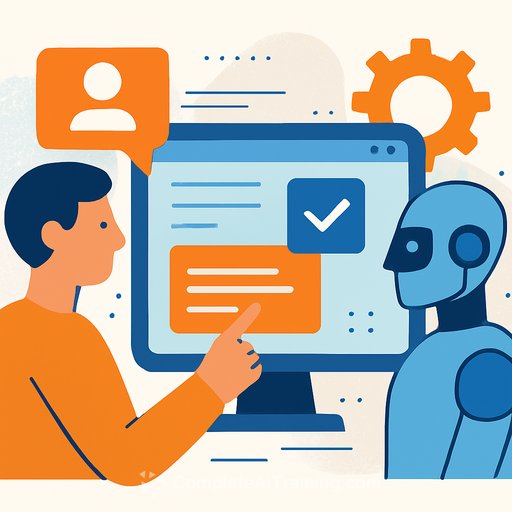Dead Internet Theory Is Gaining Ground. Here's What That Means for Your Work
The internet still runs on people, but it feels less human each month. AI-written posts, bots, and automated agents now permeate major platforms, and the trend lines point one way: more machine activity, less reliable human signal.
What once sounded fringe-the "Dead Internet Theory"-now has data behind it. Imperva's latest Bad Bot Report shows automated systems accounting for a majority of web traffic in 2024, while analytics firms tracked AI-written articles surpassing human output late that year. The experience you're having online is the product of those numbers.
What researchers are seeing
- Bot traffic hit 51% of all web activity in 2024, per Imperva's Bad Bot Report.
- Multiple studies estimate that 40-60% of social traffic is machine-generated or automated, inflating likes, comments, and shares to mimic real engagement.
- Some platforms show extreme bot saturation. One estimate pegs up to 64% of X accounts as bots responsible for the majority of peak traffic. Instagram may have ~95 million fake or automated accounts.
- "About half of the internet is AI-written," said venture investor Deedy Das. "You end up reading machines summarizing other machines."
Alex Turvy, a sociologist who studies online behavior, puts it simply: the cues we use to tell who's real are fading. As those cues blur, people retreat to smaller, semi-private spaces where trust is easier to maintain-Discords, group chats, and communities with known members.
Why this is happening
Incentives. Automated content is cheap to produce and easy to scale. Engagement metrics still reward volume, recency, and repetition, so systems churn out more of the same.
"Agentic AI can remix material at machine speed and almost no cost," said Nirav Murthy. "Engagement goes up, variety drops, and once you add human checks, the numbers fall apart."
AI agents are the accelerant
AI agents act on your behalf-browsing, scraping, buying, posting, trading, and interacting like people. That changes the baseline: platforms must assume an unknown share of users are software.
We're already seeing blowback. Amazon reportedly sent a cease-and-desist after finding a browser masking agents as human shoppers. Anthropic said it blocked what it called the first AI-driven cyberattack after state-backed actors used an agent to probe dozens of companies. As Das noted, the real risk comes from fleets: millions of agent requests that look like users and are harder to detect.
AI video is next in line
Tools like Sora 2 and Veo 3 generate realistic video from text. That's going to flood feeds with polished synthetic clips and deepfakes. Without strong provenance, the average user won't be able to tell what's real. Standards like C2PA content credentials can help, but adoption has to be wide and consistent.
What this means for people, IT, and developers
For individuals:
- Assume public engagement metrics are padded. Trust sources, not virality.
- Keep core conversations in smaller groups where identity and context are known.
- Favor creators and communities with accountability and a track record.
For IT and security teams:
- Deploy layered bot defense: WAF with behavioral challenges, device fingerprinting, rate limits, TLS fingerprint checks, and anomaly detection on login and action endpoints.
- Require signed API requests, rotate keys aggressively, and isolate high-risk actions behind additional friction (OTP, passkeys, or verified-device gates).
- Instrument agent-aware telemetry: detect headless browsers, scripted navigation patterns, and bursty request graphs from single ASN/IP ranges.
- Protect content and search surfaces with quota, cost gates, and trap endpoints to identify scrapers.
For product and engineering:
- Build a "humanness score" per session combining behavior, history, device integrity, and social graph. Gate creation and reach with it.
- Throttle distribution of repetitive, near-duplicate content; add cost to mass posting (time, verification, or spend).
- Label declared agents and give them a separate lane with caps. Undeclared agent-like behavior triggers stricter limits.
- Add content provenance: capture source hashes, editing lineage, and verified creator identity. Prefer signed uploads where feasible.
Proof of personhood will be debated
Projects like World (formerly Worldcoin), Proof of Personhood, and Human (formerly Gitcoin) Passport aim to tie online activity to verified humans. That can reduce fraud and reroute rewards to real creators, but it raises privacy and inclusion trade-offs.
There's no shared rule yet for what counts as an "agent." Expect a split internet: declared agents with caps and audits, and verified humans with higher reach and better monetization.
Operational metrics to watch
- Human/bot traffic ratio by surface (auth, search, post, purchase).
- Median session entropy: variability of clicks, dwell time, scroll, and cursor paths.
- Duplicate/near-duplicate content rate and its share of impressions.
- Post-verification survival rate of accounts after friction is applied.
- Agent-labeled request share and abuse rate vs. human sessions.
Practical playbook (start this quarter)
- Put all creation endpoints behind adaptive friction. Tie reach to reputation and verified devices.
- Ship a simple content origin tag today; upgrade to cryptographic provenance later.
- Add per-ASN, per-device, and per-user rate limits that tighten under suspicious patterns.
- Segment telemetry pipelines so Trust & Safety can iterate rules without slowing product.
- Prepare a synthetic media policy and incident workflow before the next deepfake cycle hits.
The takeaway
The internet isn't empty. It's crowded with machines that look like us. If you build or secure platforms, treat humanness as a scarce resource and architect for it.
Reduce rewards for fake engagement, raise the cost of abuse, and give verified humans better reach and payouts. Do that, and the public web won't feel so dead.
Want to upskill your team on agents, automation, and safe AI workflows? Explore practical tracks by role at Complete AI Training.
Your membership also unlocks:






